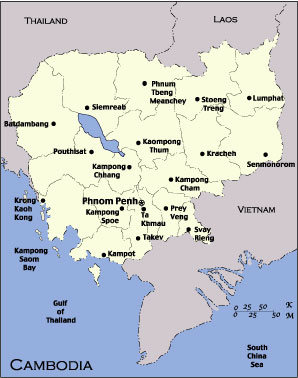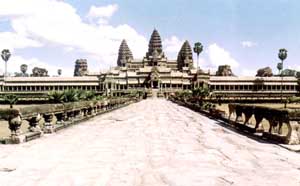Goshen College study abroad program to launch in Cambodia

GOSHEN, Ind. – As he started to receive information about political instability in Indonesia and when the country was placed on the list that the U.S. State Department doesn’t recommend as travel destinations for U.S. citizens, Goshen College Director of International Education Tom Meyers started to look for another host country in Southeast Asia for groups of students in the college’s Study-Service Term (SST) program.
“Since first sending a group in 1995, we have had wonderful experiences in Indonesia and at the Duta Wacana University there, but feel we cannot take the risk at this time of sending students to a place that is potentially unstable,” Meyers said. The college continually evaluates all SST destinations for their benefits and risks to students.
In January 2007, the first group of Goshen College students will head to Cambodia for the semester on SST. Professor of Bible, Religion and Philosophy Keith Graber Miller and his wife Ann will lead the first group of 23 students as experienced SST leaders who have taken groups to China, Cuba, Costa Rica and the Dominican Republic in the past. “Asia is part of the world that is developing the most rapidly. The whole subcontinent will be increasingly important in our global economy,” Meyers said. “We want to continue to have access to this part of the world for our students.” Groups from Goshen College will go to Cambodia every three years.
As Meyers realized that Indonesia would no longer be a location option for SST, several locations in Southeast Asia were considered as new SST destinations. “With help from Mennonite Central Committee country representatives Larry and Sherri Groff in Cambodia, we were able to explore the possibility of program in Phnom Penh and elsewhere in the country. They were very receptive from the beginning of our conversations,” Meyers said. MCC has a large presence in the country and helped Meyers contact others who could assist him in setting up a study abroad program there during a 10-day visit in January.
The SST group to Cambodia will spend the first six weeks in the capital, Phnom Penh, studying the national language of Khmer and the country’s culture at the Royal University of Phnom Penh. Students will then be placed in service assignments around the country. Because there are many nongovernmental organizations working in Cambodia, “there are lots of service learning opportunities for our students,” Meyers said. The capital is a mix of developed and developing areas, and though the country has a dollar economy, it is one of the poorest countries in the region, according to Meyers.
Students will live with host families during the first and second half of the semester, many of whom will be Buddhist, since 95 percent of the population is part of that religion. They can anticipate a diet that includes a lot of fish and rice, but is less spicy than other Southeast Asian countries.
Cambodia is located between Vietnam, Laos and Thailand, and is slightly smaller than Oklahoma. The country’s government is now a monarchy with a parliamentary system, but was under French control until 1953. The French influence can still be seen in architecture and bakeries, but fewer people speak French anymore.

The country is known for its Buddhist temples, and specifically the Anghor Wat, which is part of a complex of temples with Buddhist and Hindu symbols from the ninth to 13th centuries that thousands of tourists visit every year. The temples include huge stones carved with intricate details and brought from far away.
In the 1970s Pol Pot’s communist regime evacuated the cities and forced all citizens into agricultural work, which is the basis for the horrendous story told in the movie “The Killing Fields.” The country played a significant role in Vietnam War and the eastern part was heavily bombed by the United Sates to try and stop Northern Vietnamese from traveling through during the war.
That history and connection to the Vietnam War-era will be central to the topics the students will learn about during their time abroad in Cambodia. “As Americans we have some ongoing issues of reconciliation with Southeast Asia related to the effect of the Vietnam War on that area and on us here in the United States,” Meyers said.
Since the first SST units went to Costa Rica, Jamaica and Guadeloupe in 1968 and began one of the country’s unique international education programs, more than 6,500 students and 230 faculty leaders have traveled to 20 countries; the college currently organizes SST units to study and serve in China, Dominican Republic, Germany, Indonesia, Ethiopia, Senegal, Perú and Jamaica. The program’s uncommon combination of cultural education and service-learning remains a core part of the general education program, and has earned citations for excellence from U.S.News and World Report, Peterson’s Study Abroad and Smart Parents Guide to College, the John Templeton Foundation and American Council on Education.
For more information about Goshen’s SST program, as well as photos, journals and videos from past groups, visit www.goshen.edu/sst.
Editors: For more information about this release, to arrange an interview or request a photo, contact Goshen College News Bureau Director Jodi H. Beyeler at (574) 535-7572 or jodihb@goshen.edu.
###
Goshen College, established in 1894, is a four-year residential Christian liberal arts college rooted in the Anabaptist-Mennonite tradition. The college’s Christ-centered core values – passionate learning, global citizenship, compassionate peacemaking and servant-leadership – prepare students as leaders for the church and world. Recognized for its unique Study-Service Term program, Goshen has earned citations of excellence in Barron’s Best Buys in Education, “Colleges of Distinction,” “Making a Difference College Guide” and U.S.News & World Report’s “America’s Best Colleges” edition, which named Goshen a “least debt college.” Visit www.goshen.edu.




